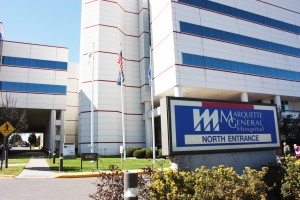Marquette General Hospital (MGH) is moving, and until recently, it was anyone’s guess where they were headed. The Marquette City Commission has accepted an offer from Duke LifePoint, the current owners of MGH, to purchase 37 acres of land in South Marquette.
Described in a map released by the hospital, the new property, now deemed the Roundhouse/MSC site, was once home to the old Soo Line railroad roundhouse. The city’s Municipal Service Center now occupies the space in an area near US-41 and Baraga Avenue — just one mile from Northern Michigan University.
“We are pleased to have reached this agreement with the City of Marquette,” President of Duke LifePoint’s Eastern Group, Jeff Seraphine, said. “Finding the right spot for the new Marquette General Hospital has been a long and thoughtful process and the RoundHouse/MSC site emerged as the best fit for our needs.” MGH’s partnership and student programs with NMU will not be affected by the move. MGH Senior Marketing Director David Edwards stressed that preserving that partnership and remaining in close proximity to NMU was one of many factors Duke LifePoint considered in choosing to stay in Marquette. He also emphasized that the new, state-of-the-art facility will only strengthen the quality of education that NMU students in healthcare and other related fields will receive.
Sophomore nursing student Celeste Gasiewicz said she was excited to have the opportunity to work in the new hospital one day, especially with the new technology that will be available. Gasiewicz may have the chance to be one of the first to experience the new facility when she graduates in 2017.
The Nashville, Tenn. architectural firm Gresham, Smith and Partners was selected from a number of bids this spring to take on the planning and design phase of the new hospital. The firm has completed projects worldwide ranging from airports, hospitals and industrial facilities. One of their notable accomplishments was the design of the new St. Bernard Parish Hospital in New Orleans, which was damaged beyond repair during Hurricane Katrina and had to be entirely rebuilt.
Duke LifePoint, who purchased the current College Avenue hospital campus in 2012, had originally planned to renovate the existing structures at a cost of roughly $230 million. However, it was determined that building a brand new hospital, which will consist of a 279-bed patient facility, and an 80,000 square foot physician’s office building, is estimated to cost $280 million.
In a press release late last year, Gary Muller, former CEO of MGH, explained the change of plans.
“Considering the hundreds of millions of dollars in capital allocated, we determined that building a true 21st century hospital is the best course for us in fulfilling our mission of providing the highest quality of care as the Upper Peninsula’s regional medical center,” Muller said.
In addition to the new hospital, other construction projects by the City of Marquette will be taking place, such as the realigning of Baraga Avenue to tie in with Spring Street, along with an expansion of Seventh Street and South Spring Street.
A new roundabout is planned for the US-41 entrance, with the construction of a new bridge on US-41 at Grove Street. Upgrades in infrastructure and utilities in the vicinity of the new hospital will also be made.
At this time, Gresham, Smith and Partners is in the process of developing schematics for the new facility, with the design being finalized later in the fall. Groundbreaking is scheduled to take place next spring and construction is scheduled to be completed toward the end of 2017.
According to MGH Marketing Director David Edwards, the current facility that straddles the NMU campus will remain open and operational until the new facility is complete.
What will become of the old location is still too early to speculate on, though he mentioned that it’s not too early to start taking suggestions. MGH will work alongside the City of Marquette and with the community to help decide their future.
When all is said and done, the current CEO of MGH, Ed Banos, contends that the new facility will be great for the community and environment alike.
“Environmentally, this is a great step forward for Marquette,” Banos said. “As we have seen with the amazing development of Marquette’s Lower Harbor, brownfield areas previously used for industrial purposes can be transformed and revitalize our community. We are very proud to be a part in this proactive environmental evolution while plotting our course toward opening the finest hospital U.P. residents could hope for.”

























